

AgriLife Today: Wild turkeys are strutting into spring
March 11, 2024
More Texans may encounter the distinct vocalizations and dramatic strutting of male turkeys seeking a mate this spring thanks to ongoing education and research collaboration by Texas A&M AgriLife and the Texas Parks and Wildlife Department.
Jacob Dykes, Ph.D., Texas A&M AgriLife Extension Service wildlife specialist, Corpus Christi, said thanks to the state’s diverse ecoregions, Texas supports three of the five total subspecies of wild turkey found in North America — the Rio Grande turkey, eastern turkey and Merriam’s turkey.
Rio Grande turkeys prefer the arid and brushy environments found throughout the Rolling Plains, Edwards Plateau, southern Post Oak Savanna and the South Texas plains, while eastern turkeys prefer areas with higher rainfall, such as the Piney Woods and bottomland hardwoods of East Texas. Merriam’s turkeys, the least common, prefer the ponderosa pines found in the Trans-Pecos mountains.
“We’re fortunate that Texas offers such a wide range of ecosystems that support diverse wildlife species like these turkey,” said Dykes, also an assistant professor in the Texas A&M College of Agriculture and Life Sciences Department of Rangeland, Wildlife and Fisheries Management. “While we’ve come a long way in restoring turkey populations across the state, there is still more work to be done to ensure they continue to thrive.”

Once on the brink of extirpation, wild turkey in Texas have experienced a comeback thanks to the collaborative efforts of state agencies, non-profits and private landowners. (Joseph Richards/Richards Outdoor Photography, LLC)
Historic population decline spurs early management actions
While the state currently boasts a thriving population of more than 500,000 wild turkeys, Dykes said this wasn’t always the case.
“The history of regulations in Texas really paint a picture of just how early Texans recognized the turkey population was declining,” said Jason Hardin, wild turkey program leader with the Texas Parks and Wildlife Department. “One of the first steps taken to address this was a three-and-a-half-month closure on turkey harvest in 1881.”
Both Hardin and Dykes note that unregulated market harvest coupled with habitat alteration were the primary forces driving the historic decline throughout the species’ historic range.
In 1942, the Texas Game, Fish and Oyster Commission, the precursor to Texas Parks and Wildlife Department, estimated that fewer than 100 turkeys remained in East Texas.
Over the following decades, Texas Parks and Wildlife biologists and partners worked in earnest to utilize stocking strategies — the capture and translocation of all three subspecies from turkey populations within and outside of Texas — as part of concerted restoration efforts. While restoration efforts have succeeded in some regions, scientists are still trying to determine why turkey populations in eastern Texas are seeing slower population recovery and limited range expansion.
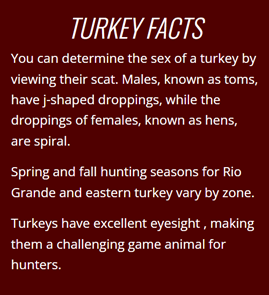
Restoration efforts
Restoration of Texas’ Rio Grande turkey population is the model for success that conservationists hope to replicate across the state. From 1920 to 2000, 33,000 Rio Grande wild turkeys were released using a variety of means across Texas, Hardin said.
Currently, Texas Parks and Wildlife considers 95% of suitable Rio Grande turkey range to be occupied by wild populations. Based on the Rio Grande’s expansive range and population success following restoration, Hardin said it’s safe to call the subspecies the “King of Texas.”
In fact, as the Rio Grande turkey range intersects with isolated populations of Merriam’s turkeys in the Davis Mountains, biologists are seeing hybridization between the two subspecies — the result of interbreeding.
While the Rio Grande turkey translocation was successful, the return of the eastern turkey was limited and required the department to reassess their stocking strategies beginning in the 1990s.
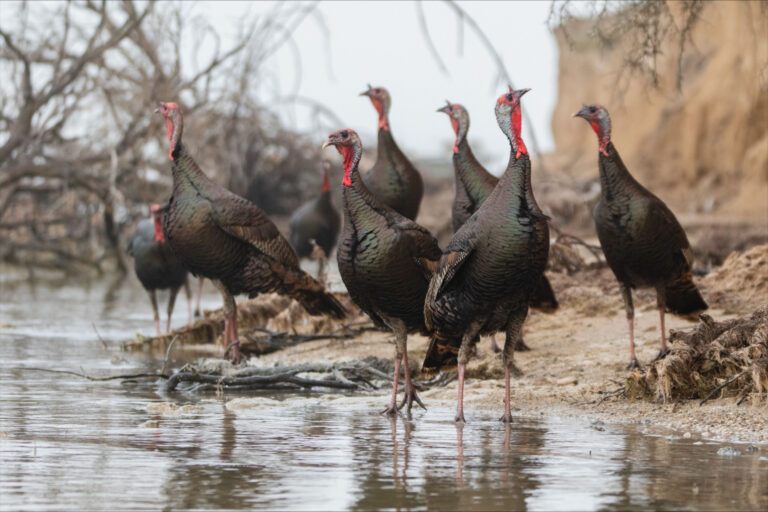

(John Tomeček, Ph.D./Texas A&M AgriLife)
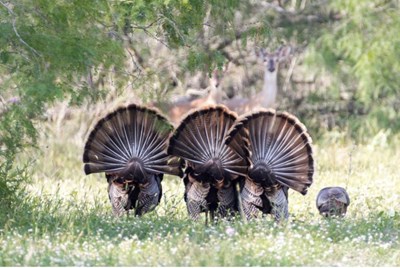
(Zach Pearson)
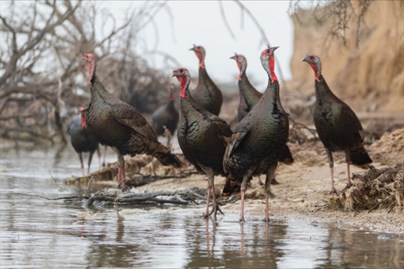
(Zach Pearson)
Restoration of Texas’ Rio Grande turkey population is the model for success that conservationists hope to replicate across the state.
Ongoing Texas A&M research contributes to recovery
To shed light on why the stocking strategies that worked for the Rio Grande turkey didn’t translate to success with eastern populations, biologists returned to the drawing board, calling on the expertise of researchers with Texas A&M University.
As a graduate student at Texas A&M in the mid-1990s, Roel Lopez, Ph.D., head of the Department of Rangeland, Wildlife and Fisheries Management and director of the Texas A&M Natural Resources Institute, used ecological modeling to simulate the dynamics of a wild turkey population under a variety of restoration strategies.
Through this process, he devised a new stocking strategy as an alternative to previous stocking approaches.
This new method, known as super stocking, called for the release of approximately 80 male and female turkeys at each restoration site as opposed to the 15-20 released through previous methods.
Hardin said research projects conducted by Texas A&M and other universities had great success implementing the super stocking method in areas of suitable East Texas habitat, and the department adopted it as the restocking standard across the region in 2014.
To support these efforts, Stephen Webb, Ph.D., Texas A&M Natural Resources Institute research assistant professor in the Department of Rangeland, Wildlife and Fisheries Management, and other researchers are using technological advances like genetic monitoring to understand and enhance the super stocking method.
Since 2014, Texas Parks and Wildlife has used the super stocking method to release over 1,100 wild turkeys from 10 different states into 10 East Texas counties, Webb said. Researchers hope to determine how these birds have influenced the genetic diversity of eastern turkeys across the relocation area.
The genetic information collected will also shed light on which populations have fared best following translocation, he said.
“Perhaps we will see that only the birds sourced from Texas, Louisiana or Missouri have thrived, while those brought in from further away aren’t surviving to successfully pass on their genetics,” Webb said. “This can help biologists make more informed decisions regarding where they source birds from in the future.”
Identifying potential habitat to expand turkey range
Rio Grande turkeys are the focus of a second project by Texas Parks and Wildlife and Webb located in Texas’ semi-arid Rolling Plains ecoregion.
Webb said turkey distribution in this region is highly dependent on available food and roosting habitat, typically found along riparian corridors.
Loss of or alteration to these habitats are of increasing concern due to the potential negative impact on Rio Grande turkey populations.
Utilizing geospatial data to classify the land use and land cover of turkey roost locations obtained in the early 2000s, researchers can use models to predict areas of potential roosting habitat and how they have changed over the past 20 years.
“Using this data, we can assess how land use and land cover has changed and what effect that potential change has had on roosting availability,” Webb said. “This will help Texas Parks and Wildlife prioritize areas of conservation need in the region.”
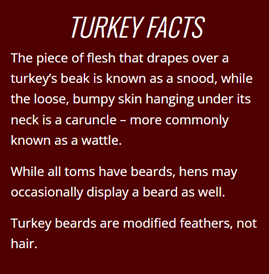
How landowners can benefit turkey
As the landscape of Texas continues to change through increased fragmentation and urban/suburban encroachment, Dykes said management activities on private lands are critical to supporting conservation efforts for all three subspecies.
“Like a lot of wildlife, turkey require different types of habitat throughout the year depending on their life cycle,” Dykes said. “This is especially true when it comes to nesting and rearing poults.”
Dykes said turkey rely on the cover and composition historically provided by native bunch grass species to provide adequate nesting coverage but also adequate spacing for poults to move and forage alongside their mother while also avoiding predators.
“Incorporating native grasses and herbaceous flowering species into landscapes can help provide habitat and food sources for these and other native birds,” Dykes said. “This impact is also greatly amplified when landowners take a ‘neighborhood’ approach to conservation.”
Dykes said when landowners work together to collectively implement management practices benefiting turkey, other wildlife benefit across the landscape as well.
In East Texas, providing habitat could mean maintaining an open forest canopy through thinning as well as prescribed fire to foster the growth of beneficial understory plant species, he said.
In western portions of the state where roosting resources may be limited, Dykes said artificial turkey roosts can provide a safe alternative and protect roosting birds from predators.
Webb said certain efforts such as food plots and predator control may benefit turkey in the short term, but they don’t address the root cause of turkey decline.
“It still comes down to conserving and managing turkey habitat properly to provide the resources they need to survive,” Webb said. “We hope the knowledge we gain through our ongoing research will help empower biologists and landowners to do just that.”
--
by Sarah Fuller (sarah.fuller@ag.tamu.edu)





